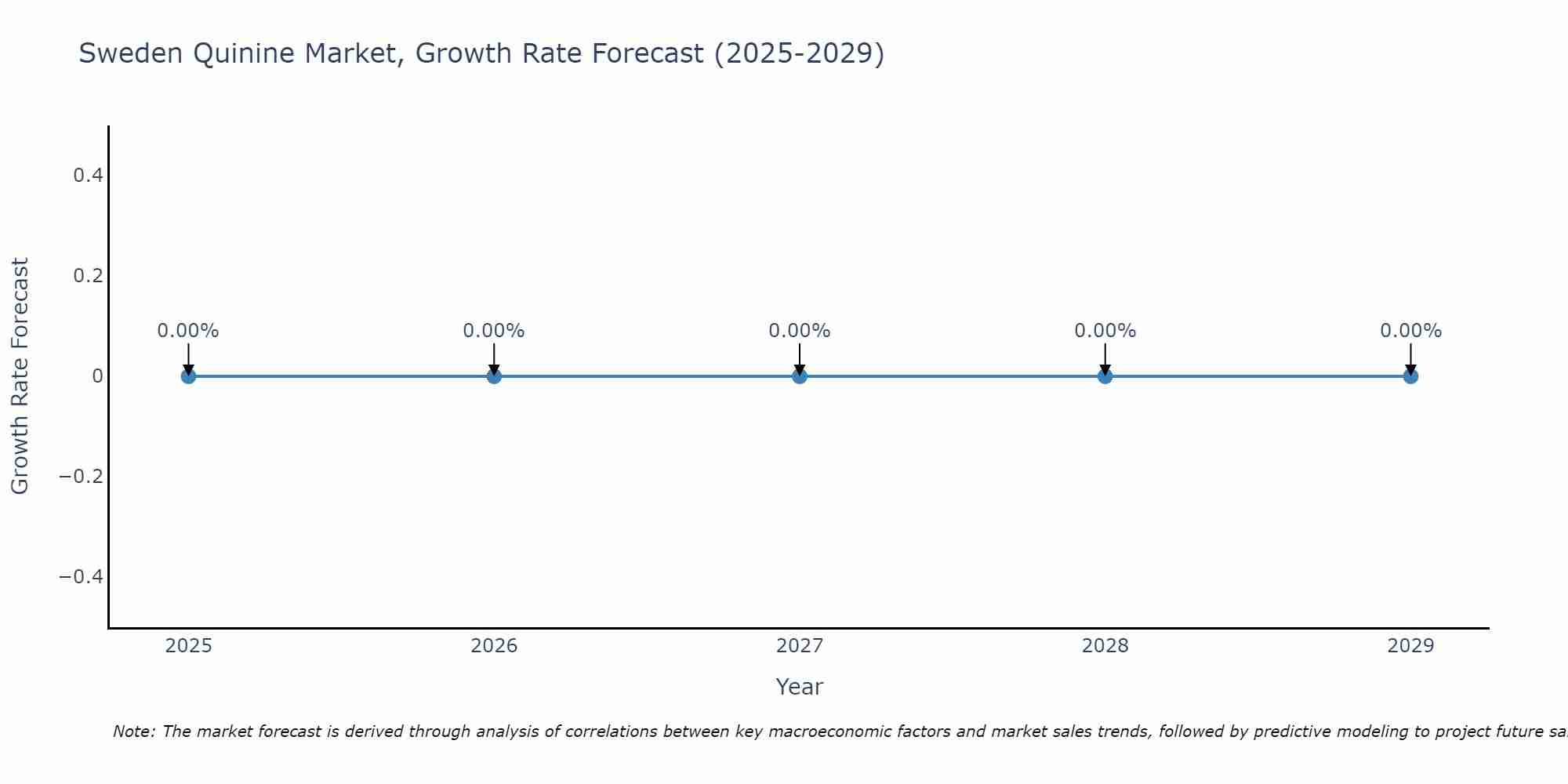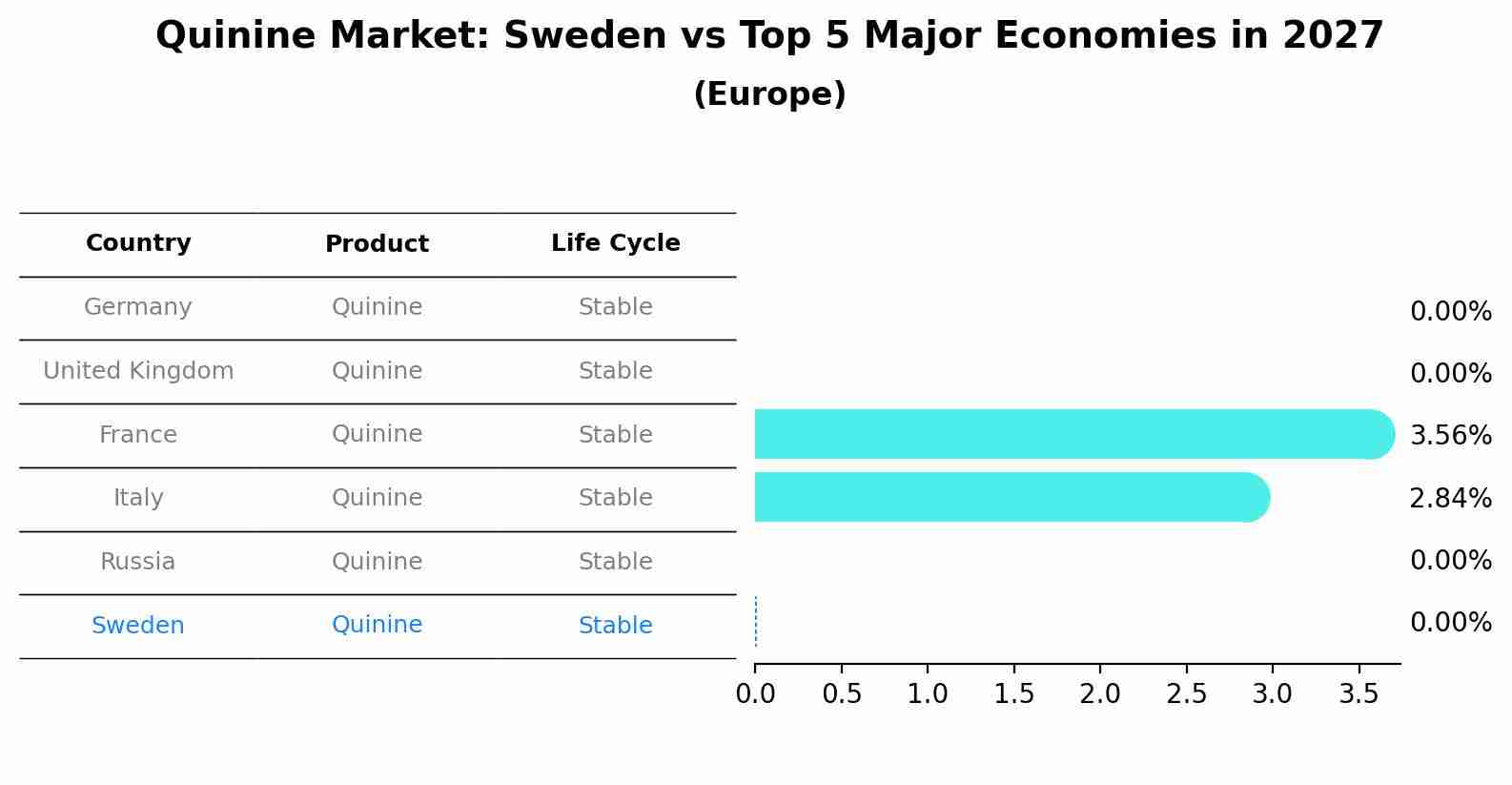Sweden Quinine Market (2025-2031) | Forecast, Share, Revenue, Growth, Size, Analysis, Industry, Trends, Outlook, Segmentation, Value & Companies
| Product Code: ETC5312527 | Publication Date: Nov 2023 | Updated Date: Aug 2025 | Product Type: Market Research Report | |
| Publisher: 6Wresearch | Author: Bhawna Singh | No. of Pages: 60 | No. of Figures: 30 | No. of Tables: 5 |
Sweden Quinine Market Size Growth Rate
The Sweden Quinine Market is expected to maintain a stable growth rate from 2025 to 2029. Starting high at 0.00% in 2025, the market steadily declines to 0.00% by 2029.

Quinine Market: Sweden vs Top 5 Major Economies in 2027 (Europe)
By 2027, Sweden's Quinine market is forecasted to achieve a stable growth rate of 0.00%, with Germany leading the Europe region, followed by United Kingdom, France, Italy and Russia.

Sweden Quinine Market Overview
Sweden quinine market is primarily driven by its applications in the pharmaceutical industry, where quinine is used as a treatment for malaria. Additionally, quinine is used as a flavoring agent in beverages like tonic water. With the increased demand for antimalarial treatments and the continued popularity of tonic drinks, the market for quinine in Sweden is stable. The global supply chain for quinine, which is extracted from the bark of the cinchona tree, plays a role in determining market dynamics.
Drivers of the market
The quinine market in Sweden is influenced by the ongoing demand for antimalarial medications and the rising popularity of quinine as a flavoring agent in tonic water. The need for effective treatments against malaria drives the demand for quinine, particularly in regions where the disease remains prevalent. Additionally, the growing interest in natural remedies and herbal products supports the use of quinine in various health and wellness applications.
Challenges of the market
The quinine market is challenged by fluctuating demand influenced by its primary use in treating malaria. Changes in global malaria rates and the effectiveness of alternative treatments can significantly impact quinine sales. Additionally, regulatory challenges related to the production and distribution of pharmaceutical ingredients can complicate operations for manufacturers. The market also faces pressure to ensure sustainable sourcing of cinchona bark, the raw material for quinine, amid increasing environmental concerns and competition from synthetic alternatives.
Government Policy of the market
In Sweden, the quinine market is shaped by government regulations that ensure the safety and efficacy of pharmaceutical products. The Swedish Medical Products Agency oversees the approval and regulation of quinine for medical use, ensuring that it meets strict safety standards. Additionally, policies promoting research into alternative treatments and the development of more effective formulations contribute to market growth. The government emphasis on public health and safety drives the demand for regulated and effective quinine products.
Key Highlights of the Report:
- Sweden Quinine Market Outlook
- Market Size of Sweden Quinine Market, 2024
- Forecast of Sweden Quinine Market, 2031
- Historical Data and Forecast of Sweden Quinine Revenues & Volume for the Period 2021-2031
- Sweden Quinine Market Trend Evolution
- Sweden Quinine Market Drivers and Challenges
- Sweden Quinine Price Trends
- Sweden Quinine Porter`s Five Forces
- Sweden Quinine Industry Life Cycle
- Historical Data and Forecast of Sweden Quinine Market Revenues & Volume By Mode of Administration for the Period 2021-2031
- Historical Data and Forecast of Sweden Quinine Market Revenues & Volume By Oral Administration for the Period 2021-2031
- Historical Data and Forecast of Sweden Quinine Market Revenues & Volume By Intravenous Administration for the Period 2021-2031
- Historical Data and Forecast of Sweden Quinine Market Revenues & Volume By Intramuscular Administration for the Period 2021-2031
- Historical Data and Forecast of Sweden Quinine Market Revenues & Volume By Others for the Period 2021-2031
- Historical Data and Forecast of Sweden Quinine Market Revenues & Volume By Application for the Period 2021-2031
- Historical Data and Forecast of Sweden Quinine Market Revenues & Volume By Antimalarial for the Period 2021-2031
- Historical Data and Forecast of Sweden Quinine Market Revenues & Volume By Antipyretic for the Period 2021-2031
- Historical Data and Forecast of Sweden Quinine Market Revenues & Volume By Others for the Period 2021-2031
- Historical Data and Forecast of Sweden Quinine Market Revenues & Volume By End-user for the Period 2021-2031
- Historical Data and Forecast of Sweden Quinine Market Revenues & Volume By Hospitals for the Period 2021-2031
- Historical Data and Forecast of Sweden Quinine Market Revenues & Volume By Clinics for the Period 2021-2031
- Historical Data and Forecast of Sweden Quinine Market Revenues & Volume By Ambulatory Surgical Centers for the Period 2021-2031
- Historical Data and Forecast of Sweden Quinine Market Revenues & Volume By Others for the Period 2021-2031
- Sweden Quinine Import Export Trade Statistics
- Market Opportunity Assessment By Mode of Administration
- Market Opportunity Assessment By Application
- Market Opportunity Assessment By End-user
- Sweden Quinine Top Companies Market Share
- Sweden Quinine Competitive Benchmarking By Technical and Operational Parameters
- Sweden Quinine Company Profiles
- Sweden Quinine Key Strategic Recommendations
Frequently Asked Questions About the Market Study (FAQs):
1 Executive Summary |
2 Introduction |
2.1 Key Highlights of the Report |
2.2 Report Description |
2.3 Market Scope & Segmentation |
2.4 Research Methodology |
2.5 Assumptions |
3 Sweden Quinine Market Overview |
3.1 Sweden Country Macro Economic Indicators |
3.2 Sweden Quinine Market Revenues & Volume, 2021 & 2031F |
3.3 Sweden Quinine Market - Industry Life Cycle |
3.4 Sweden Quinine Market - Porter's Five Forces |
3.5 Sweden Quinine Market Revenues & Volume Share, By Mode of Administration, 2021 & 2031F |
3.6 Sweden Quinine Market Revenues & Volume Share, By Application, 2021 & 2031F |
3.7 Sweden Quinine Market Revenues & Volume Share, By End-user, 2021 & 2031F |
4 Sweden Quinine Market Dynamics |
4.1 Impact Analysis |
4.2 Market Drivers |
4.2.1 Increasing consumer awareness about the health benefits of quinine |
4.2.2 Growing demand for natural and herbal remedies in Sweden |
4.2.3 Rising prevalence of diseases that can be treated using quinine |
4.3 Market Restraints |
4.3.1 Stringent regulations on the use of quinine in certain products |
4.3.2 Potential side effects and health risks associated with quinine consumption |
5 Sweden Quinine Market Trends |
6 Sweden Quinine Market Segmentations |
6.1 Sweden Quinine Market, By Mode of Administration |
6.1.1 Overview and Analysis |
6.1.2 Sweden Quinine Market Revenues & Volume, By Oral Administration, 2021-2031F |
6.1.3 Sweden Quinine Market Revenues & Volume, By Intravenous Administration, 2021-2031F |
6.1.4 Sweden Quinine Market Revenues & Volume, By Intramuscular Administration, 2021-2031F |
6.1.5 Sweden Quinine Market Revenues & Volume, By Others, 2021-2031F |
6.2 Sweden Quinine Market, By Application |
6.2.1 Overview and Analysis |
6.2.2 Sweden Quinine Market Revenues & Volume, By Antimalarial, 2021-2031F |
6.2.3 Sweden Quinine Market Revenues & Volume, By Antipyretic, 2021-2031F |
6.2.4 Sweden Quinine Market Revenues & Volume, By Others, 2021-2031F |
6.3 Sweden Quinine Market, By End-user |
6.3.1 Overview and Analysis |
6.3.2 Sweden Quinine Market Revenues & Volume, By Hospitals, 2021-2031F |
6.3.3 Sweden Quinine Market Revenues & Volume, By Clinics, 2021-2031F |
6.3.4 Sweden Quinine Market Revenues & Volume, By Ambulatory Surgical Centers, 2021-2031F |
6.3.5 Sweden Quinine Market Revenues & Volume, By Others, 2021-2031F |
7 Sweden Quinine Market Import-Export Trade Statistics |
7.1 Sweden Quinine Market Export to Major Countries |
7.2 Sweden Quinine Market Imports from Major Countries |
8 Sweden Quinine Market Key Performance Indicators |
8.1 Number of new product launches containing quinine in Sweden |
8.2 Consumer perception and acceptance of quinine-based products |
8.3 Research and development investment in quinine-related studies and applications |
9 Sweden Quinine Market - Opportunity Assessment |
9.1 Sweden Quinine Market Opportunity Assessment, By Mode of Administration, 2021 & 2031F |
9.2 Sweden Quinine Market Opportunity Assessment, By Application, 2021 & 2031F |
9.3 Sweden Quinine Market Opportunity Assessment, By End-user, 2021 & 2031F |
10 Sweden Quinine Market - Competitive Landscape |
10.1 Sweden Quinine Market Revenue Share, By Companies, 2024 |
10.2 Sweden Quinine Market Competitive Benchmarking, By Operating and Technical Parameters |
11 Company Profiles |
12 Recommendations | 13 Disclaimer |
- Single User License$ 1,995
- Department License$ 2,400
- Site License$ 3,120
- Global License$ 3,795
Search
Thought Leadership and Analyst Meet
Our Clients
Related Reports
- Germany Breakfast Food Market (2026-2032) | Industry, Share, Growth, Size, Companies, Value, Analysis, Revenue, Trends, Forecast & Outlook
- Australia Briquette Market (2025-2031) | Growth, Size, Revenue, Forecast, Analysis, Trends, Value, Share, Industry & Companies
- Vietnam System Integrator Market (2025-2031) | Size, Companies, Analysis, Industry, Value, Forecast, Growth, Trends, Revenue & Share
- ASEAN and Thailand Brain Health Supplements Market (2025-2031) | Strategy, Consumer Insights, Analysis, Investment Trends, Opportunities, Growth, Size, Share, Industry, Revenue, Segments, Value, Segmentation, Supply, Forecast, Restraints, Outlook, Competition, Drivers, Trends, Demand, Pricing Analysis, Competitive, Strategic Insights, Companies, Challenges
- ASEAN Bearings Market (2025-2031) | Strategy, Consumer Insights, Analysis, Investment Trends, Opportunities, Growth, Size, Share, Industry, Revenue, Segments, Value, Segmentation, Supply, Forecast, Restraints, Outlook, Competition, Drivers, Trends, Demand, Pricing Analysis, Competitive, Strategic Insights, Companies, Challenges
- Europe Flooring Market (2025-2031) | Outlook, Share, Industry, Trends, Forecast, Companies, Revenue, Size, Analysis, Growth & Value
- Saudi Arabia Manlift Market (2025-2031) | Outlook, Size, Growth, Trends, Companies, Industry, Revenue, Value, Share, Forecast & Analysis
- Uganda Excavator, Crane, and Wheel Loaders Market (2025-2031) | Strategy, Consumer Insights, Analysis, Investment Trends, Opportunities, Growth, Size, Share, Industry, Revenue, Segments, Value, Segmentation, Supply, Forecast, Restraints, Outlook, Competition, Drivers, Trends, Demand, Pricing Analysis, Competitive, Strategic Insights, Companies, Challenges
- Rwanda Excavator, Crane, and Wheel Loaders Market (2025-2031) | Strategy, Consumer Insights, Analysis, Investment Trends, Opportunities, Growth, Size, Share, Industry, Revenue, Segments, Value, Segmentation, Supply, Forecast, Restraints, Outlook, Competition, Drivers, Trends, Demand, Pricing Analysis, Competitive, Strategic Insights, Companies, Challenges
- Kenya Excavator, Crane, and Wheel Loaders Market (2025-2031) | Strategy, Consumer Insights, Analysis, Investment Trends, Opportunities, Growth, Size, Share, Industry, Revenue, Segments, Value, Segmentation, Supply, Forecast, Restraints, Outlook, Competition, Drivers, Trends, Demand, Pricing Analysis, Competitive, Strategic Insights, Companies, Challenges
Industry Events and Analyst Meet
Whitepaper
- Middle East & Africa Commercial Security Market Click here to view more.
- Middle East & Africa Fire Safety Systems & Equipment Market Click here to view more.
- GCC Drone Market Click here to view more.
- Middle East Lighting Fixture Market Click here to view more.
- GCC Physical & Perimeter Security Market Click here to view more.
6WResearch In News
- Doha a strategic location for EV manufacturing hub: IPA Qatar
- Demand for luxury TVs surging in the GCC, says Samsung
- Empowering Growth: The Thriving Journey of Bangladesh’s Cable Industry
- Demand for luxury TVs surging in the GCC, says Samsung
- Video call with a traditional healer? Once unthinkable, it’s now common in South Africa
- Intelligent Buildings To Smooth GCC’s Path To Net Zero


















